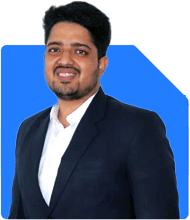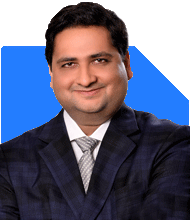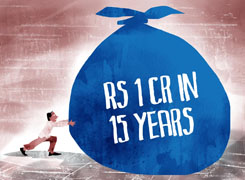Ramalingam Kalirajan |10874 Answers |Ask -Follow
Mutual Funds, Financial Planning Expert - Answered on Jun 06, 2024
He has an MBA in finance from the University of Madras and is a certified financial planner.
He is the director and chief financial planner at Holistic Investment, a Chennai-based firm that offers financial planning and wealth management advice.... more

Hello Sir, I am 36 years old and looking at a corpus of around 50 lakhs in 5-8 years. I am very new to Mutual Funds investing honestly. I have invested in Aditya Birla PSU Equity fund Direct Growth - 1,50,000 this very month and ICICI Prudential Bharat 22 FOF Direct Plan - One time 1,00,000 and an SIP of 15,000 per month in Tata Small Cap Fund Direct Growth. I’m looking at investing another 3,50,000 readily plus another SIP of 15,000 a month. Can you please advise how to go about it. Thank you so much Sir. Divya
Congratulations on your proactive approach to investing! With a goal of Rs 50 lakhs in 5-8 years, and considering your existing investments, let's develop a comprehensive plan. You've already started with some mutual funds, and you’re looking to invest an additional Rs 3.5 lakhs and continue monthly SIPs of Rs 15,000. Here’s how you can optimize your investment strategy.
Understanding Your Investment Horizon and Risk Appetite
Your target of Rs 50 lakhs in 5-8 years is achievable with a disciplined approach. Given this medium-term horizon, a balanced portfolio with a mix of equity and debt funds can help manage risk while aiming for good returns.
Reviewing Your Current Investments
You’ve invested in:
Aditya Birla PSU Equity Fund Direct Growth: Rs 1.5 lakhs
ICICI Prudential Bharat 22 FOF Direct Plan: Rs 1 lakh
Tata Small Cap Fund Direct Growth: SIP of Rs 15,000 per month
Investment in Direct Funds
Direct funds often have lower expense ratios, but they require more monitoring. Since you are new to mutual funds, investing through a Mutual Fund Distributor (MFD) with Certified Financial Planner (CFP) credentials can offer professional advice and active management.
Evaluating the Current Portfolio
PSU Equity Fund: Focuses on public sector undertakings. While potentially rewarding, it can be sector-specific and volatile.
Bharat 22 FOF: A fund of funds investing in Bharat 22 ETF. It's diversified but closely tied to the performance of selected public sector enterprises.
Small Cap Fund: High growth potential but with higher volatility. Suitable for long-term investment but requires risk tolerance.
Diversifying Your Portfolio
A diversified portfolio balances risk and reward. Here are some suggestions:
1. Large Cap Funds
Large cap funds invest in well-established companies. They offer stability and steady returns. Allocate a portion of your Rs 3.5 lakhs here for a balanced approach.
2. Multi Cap Funds
Multi cap funds invest across market capitalizations (large, mid, and small caps). They offer diversification within a single fund, reducing risk while providing growth opportunities.
3. Balanced or Hybrid Funds
Balanced or hybrid funds invest in both equities and debt. They provide growth potential with the stability of fixed-income investments. This can be a good option for conservative investors looking for balanced risk and reward.
4. Debt Funds
Debt funds invest in bonds and other fixed-income securities. They offer lower risk and stable returns. Allocating a portion to debt funds can stabilize your portfolio, especially for short-term goals.
Proposed Allocation of Additional Rs 3.5 Lakhs
Large Cap Fund: Rs 1 lakh
Multi Cap Fund: Rs 1 lakh
Balanced/Hybrid Fund: Rs 1 lakh
Debt Fund: Rs 50,000
Systematic Investment Plans (SIPs)
Continue with your existing SIP of Rs 15,000 in Tata Small Cap Fund. Start another SIP of Rs 15,000 as follows:
Large Cap Fund: Rs 5,000 per month
Multi Cap Fund: Rs 5,000 per month
Balanced/Hybrid Fund: Rs 5,000 per month
Why Choose Regular Funds through MFD with CFP
Professional Guidance: CFPs offer personalized advice tailored to your financial goals and risk appetite.
Active Management: Regular funds managed by professionals can adapt to market changes, potentially outperforming passive funds.
Peace of Mind: Regular monitoring and adjustments by professionals ensure your investments align with your goals.
Calculating Expected Returns
Assuming an average annual return of 10-12% from equity funds and 7-8% from debt funds, let's estimate the future value of your investments.
Lump Sum Investments
Rs 3.5 lakhs in diversified funds with an average return of 10% over 5-8 years
Using the compound interest formula:
FV = P (1 + r/n)^(nt)
For simplicity, let's assume annual compounding.
After 5 years:
FV = 3,50,000 (1 + 0.10)^5 ≈ Rs 5.64 lakhs
After 8 years:
FV = 3,50,000 (1 + 0.10)^8 ≈ Rs 7.51 lakhs
SIP Investments
Rs 30,000 per month (Rs 15,000 existing + Rs 15,000 new) with an average return of 10% over 5-8 years
Total Estimated Corpus
Combining lump sum and SIP investments:
After 5 years: Rs 5.64 lakhs (lump sum) + Rs 23.23 lakhs (SIP) ≈ Rs 28.87 lakhs
After 8 years: Rs 7.51 lakhs (lump sum) + Rs 45.82 lakhs (SIP) ≈ Rs 53.33 lakhs
You are likely to achieve your goal of Rs 50 lakhs within 8 years, possibly even sooner.
Regular Monitoring and Adjustments
Regularly review your portfolio's performance. Adjust your SIPs and allocations based on market conditions and personal financial changes. A CFP can help with these adjustments.
Conclusion
Your goal of Rs 50 lakhs in 5-8 years is achievable with a well-diversified investment strategy. By reallocating your lump sum and SIP investments into large cap, multi cap, balanced/hybrid, and debt funds, you balance growth potential and risk. Investing through a Mutual Fund Distributor with CFP credentials offers professional guidance and peace of mind. Regular monitoring and adjustments will ensure you stay on track to meet your financial goals.
Best Regards,
K. Ramalingam, MBA, CFP,
Chief Financial Planner,
www.holisticinvestment.in
You may like to see similar questions and answers below
Nikunj Saraf | Answer |Ask -Follow
Mutual Funds Expert - Answered on Sep 26, 2022
Nikunj Saraf | Answer |Ask -Follow
Mutual Funds Expert - Answered on Sep 27, 2022
Nikunj Saraf | Answer |Ask -Follow
Mutual Funds Expert - Answered on Oct 06, 2022
Nikunj Saraf | Answer |Ask -Follow
Mutual Funds Expert - Answered on Apr 19, 2023
Hardik Parikh | Answer |Ask -Follow
Tax, Mutual Fund Expert - Answered on May 03, 2023
Mayank Chandel |2567 Answers |Ask -Follow
IIT-JEE, NEET-UG, SAT, CLAT, CA, CS Exam Expert - Answered on Dec 08, 2025
Mayank Chandel |2567 Answers |Ask -Follow
IIT-JEE, NEET-UG, SAT, CLAT, CA, CS Exam Expert - Answered on Dec 08, 2025
Mayank Chandel |2567 Answers |Ask -Follow
IIT-JEE, NEET-UG, SAT, CLAT, CA, CS Exam Expert - Answered on Dec 08, 2025
Mayank Chandel |2567 Answers |Ask -Follow
IIT-JEE, NEET-UG, SAT, CLAT, CA, CS Exam Expert - Answered on Dec 08, 2025
Anu Krishna |1746 Answers |Ask -Follow
Relationships Expert, Mind Coach - Answered on Dec 08, 2025
Ramalingam Kalirajan |10874 Answers |Ask -Follow
Mutual Funds, Financial Planning Expert - Answered on Dec 08, 2025
Samraat Jadhav |2499 Answers |Ask -Follow
Stock Market Expert - Answered on Dec 08, 2025
Ramalingam Kalirajan |10874 Answers |Ask -Follow
Mutual Funds, Financial Planning Expert - Answered on Dec 08, 2025
Radheshyam Zanwar |6737 Answers |Ask -Follow
MHT-CET, IIT-JEE, NEET-UG Expert - Answered on Dec 08, 2025
Nayagam P P |10852 Answers |Ask -Follow
Career Counsellor - Answered on Dec 07, 2025

Research Career Prospects: IISc, IITs, and Beyond: For research-oriented careers, the Integrated M.Sc Physics program at Amrita provides an exceptional foundation. Amrita's curriculum specifically aligns with GATE and UGC-NET examination syllabi, and the institution emphasizes early research engagement. The faculty at Amrita actively publish research in Scopus-indexed journals, with over 60 publications in international venues within the past five years, exposing you to active research environments.
To pursue research at premier institutions like IISc, you would typically follow the PhD pathway. IISc accepts M.Sc graduates through their Integrated PhD programs, and with your Amrita M.Sc, you're eligible to apply. You'll need to qualify the relevant entrance examinations, and your integrated program's emphasis on research fundamentals provides strong preparation. The final year of your Integrated M.Sc is intentionally structured to be nearly free of classroom commitments, enabling engagement with research projects at institutes like IISc, IITs, and National Labs. According to Amrita's data, over 80% of M.Sc Physics students secured internship offers from reputed institutions during academic year 2019-20, directly facilitating research career transitions.
Placement and Direct Employment Opportunities: Amrita University boasts a comprehensive placement ecosystem with strong corporate and government sector connections. According to NIRF placement data for the Amrita Integrated M.Sc program (5-year), the median salary in 2023-24 stood at ?7.2 LPA with approximately 57% placement rate. However, these figures reflect general placement trends; physics graduates often secure higher packages in specialized technical roles. Many graduates join software companies like Infosys (with early offers), Google, and PayPal, where their strong analytical and computational skills command competitive compensation packages ranging from ?8-15 LPA for entry-level positions.
The Department of Corporate and Industrial Relations at Amrita provides intensive three-semester life skills training covering linguistic competence, data interpretation, group discussions, and interview techniques. This structured placement support significantly enhances your employability in both government and private sectors.
Government Sector Opportunities: UPSC, BARC, DRDO, and ISRO: Your M.Sc Physics degree opens multiple avenues for prestigious government employment. UPSC Geophysicist examinations explicitly list M.Sc Physics or Applied Physics as qualifying degrees, enabling you to compete for Group A positions in the Geological Survey of India and Central Ground Water Board. The age limit for geophysicist positions is 32 years (with relaxation for reserved categories), and the exam comprises preliminary, main, and interview stages.
BARC (Bhabha Atomic Research Centre) actively recruits M.Sc Physics graduates as Scientific Officers and Research Fellows. Recruitment occurs through the BARC Online Test or GATE scores, with positions in nuclear science, radiation protection, and atomic research. BARC Summer Internship programs are available, offering ?5,000-?10,000 monthly stipends with opportunity for future scientist recruitment.
DRDO (Defense Research and Development Organization) recruits M.Sc Physics graduates through CEPTAM examinations or GATE scores for roles involving defense technology, weapon systems, and laser physics research. ISRO (Indian Space Research Organisation) regularly advertises scientist/engineer positions through competitive recruitment for candidates with strong physics backgrounds, offering opportunities in satellite technology and space science applications.
Other significant employers include the Indian Meteorological Department (IMD) recruiting as scientific officers, and NPCIL (Nuclear Power Corporation of India Limited), offering stable government service with competitive compensation packages exceeding ?8-12 LPA for scientists.
Alternate Career Pathways: UPSC, CDS, and AFCAT: UPSC Civil Services (IFS - Indian Forest Service): M.Sc Physics graduates qualify for UPSC Civil Services examinations, with the forest service offering opportunities for science-based administrative roles with potential to reach senior government positions.
CDS/AFCAT (Armed Forces): While AFCAT meteorology branches specifically require "B.Sc with Maths & Physics with 60% minimum marks," the technical branches (Aeronautical Engineering and Ground Duty Technical roles) require graduation/integrated postgraduation in Engineering/Technology. An M.Sc Physics integrates well with technical qualifications, though you would need engineering background for direct officer entry. However, you remain eligible for specialized technical interviews if applying through alternate defence channels.
UGC-NET Examination: This pathway leads to Assistant Professor positions in central universities and colleges across India. NET-qualified candidates receive scholarships of ?31,000/month for 2-year JRF positions with PhD pursuit, transitioning to Assistant Professor salaries of ?41,000/month in government institutions. This route provides long-term academic career security with research opportunities.
Private Sector Technical Roles
M.Sc Physics graduates are increasingly valued in data science, software engineering, and technical consulting. Companies actively recruit physics graduates for software development, where strong problem-solving and logical reasoning translate to competitive packages of ?10-20 LPA. Specialized domains including quantum computing development, financial modeling, and scientific computing offer premium compensation. Your minor in Scientific Computing makes you particularly attractive to technology companies requiring computational expertise.
International Opportunities and Higher Studies Abroad
An M.Sc from Amrita facilitates admission to PhD programs at international institutions. German universities offer tuition-free or low-fee MSc Physics programs (2 years) with scholarships like DAAD providing €850+ monthly stipends. US universities accept M.Sc graduates directly for PhD positions with full funding (tuition coverage + stipend). These pathways require GRE scores and strong Statement of Purpose articulating research interests. Research collaboration opportunities exist with Max Planck Institute (Germany) and CalTech Summer Research Program (USA), both welcoming Indian M.Sc students.
Essential Skills and Certifications to Develop Immediately: Programming Languages: Start learning Python immediately—it's universally used in research and industry. Dedicate 2-3 hours weekly to data analysis, scientific computing libraries (NumPy, SciPy, Pandas), and machine learning fundamentals. MATLAB is equally critical for physics applications, particularly numerical simulations and data visualization. Aim to complete MATLAB certification courses within your first year.
Research Tools: Learn Git/version control, LaTeX for scientific documentation, and data analysis frameworks. These skills are indispensable for publishing research papers and collaborating on projects.
Certifications Worth Pursuing: (1) MATLAB Certification (DIYguru or MathWorks official courses) (2) Python for Data Science (complete certificate programs from platforms like Coursera) (3) Machine Learning Fundamentals (for expanding technical versatility) & (4) Scientific Communication and Technical Writing (develop through departmental workshops)
Strategic Internship Planning: Leverage Amrita's research connections systematically. In your third year, apply to BARC Summer Internship, IISER Internships, TIFR Summer Fellowships, and IIT Internship programs (like IIT Kanpur SURGE). These expose you to frontier research while establishing connections for future PhD or scientist recruitment. Target 2-3 research internships across different specializations to develop versatility.
TO SUM UP, Your Integrated M.Sc Physics degree from Amrita positions you exceptionally well for competitive research careers at IISc/IITs, prestigious government scientist roles at BARC/DRDO/ISRO, and international PhD opportunities. The program's scientific computing emphasis differentiates you in the job market. Immediate priorities: (1) Master Python and MATLAB within the first two years; (2) Engage in research projects starting year 2-3; (3) Target internships at premiere research institutions; (4) Prepare GATE while completing your degree for maximum flexibility in recruitment; (5) Consider UGC-NET for long-term academic stability. Your career trajectory will ultimately depend on developing strong research fundamentals, demonstrating consistent excellence in specialization areas, and strategically selecting internship and research opportunities. The rigorous Amrita program combined with disciplined skill development positions you for exceptional career success across multiple sectors. Choose the most suitable option for you out of the various options available mentioned above. All the BEST for Your Prosperous Future!
Follow RediffGURUS to Know More on 'Careers | Money | Health | Relationships'.



























